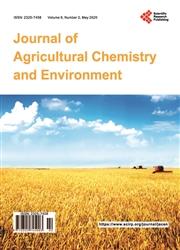Waste Management Systems among Smallholder Farmers in Masaka and Lyantonde Districts, Central Uganda
引用次数: 5
Abstract
With diversity in farming systems, crop residues, animal wastes and management practices are often not well managed, and most of it is left on the soil surface. This practice is common, especially among smallholder farmers (SHFs). There is no updated record of commonly used waste management practices. Our study focused on smallholder farmers in two farming systems in Masaka and Lyantonde Districts respectively, and with the objective to determine smallholder waste management practices in relation to farm waste components. Using a sample survey, quantitative data were collected from 120 SHFs representing 10.1% of the total SHF population in the Masaka while 120 SHFs provided data and represented 17.4% of the total SHF population in Lyantonde. Our result revealed that for animal waste, Goat slurry 20.4%, dominated the rest in Lyantonde, while in Masaka Pig slurry 23.6%, was dominant. For crop waste in Lyantonde, Bean trashes 12.9%, dominated, while in Masaka Banana leaves and peelings 11.1%, were dominant. In Lyantonde, common waste management practices were: Surface deposition 41.2%, Burning 18.4% Composting 17.3%, Burying 9.4%, Removal 10.9% and Recycling 2.8%. In Masaka, common practices were: Surface deposition 40.9%, Burning 18.6% Composting 13.2%, Burrying 12.3%, Removal 6.2% and Recycling 8.8%. Factors affecting choice of waste management practices by SHFs were: Age, purpose of waste product, season, quantity of the wastes, waste management policy awareness, farmer’s commitment and economic status of the farmer. Greenhouse gas emission for identified waste management practices across the two Districts shall be determined in our next study.乌干达中部Masaka和Lyantonde区小农户的废物管理系统
由于农业系统的多样性,作物残茬、动物粪便和管理方法往往没有得到很好的管理,其中大部分留在土壤表面。这种做法很常见,尤其是在小农中。没有关于常用废物管理方法的最新记录。我们的研究重点是分别在Masaka和Lyantonde地区的两个耕作系统中的小农,目的是确定与农业废物成分相关的小农废物管理做法。通过抽样调查,从占Masaka地区SHF总数10.1%的120个SHF中收集了定量数据,而120个SHF提供了数据,占Lyantonde地区SHF总数的17.4%。结果表明,在动物粪便中,羊浆占20.4%,利安东德区占绝大多数,而马萨卡区占23.6%。Lyantonde的作物废弃物以豆类垃圾为主,占12.9%,而Masaka的香蕉叶片和果皮占11.1%。在Lyantonde,常见的废物管理方法是:表面沉积41.2%,燃烧18.4%,堆肥17.3%,掩埋9.4%,去除10.9%和回收2.8%。在Masaka,常见的做法是:表面沉积40.9%,燃烧18.6%,堆肥13.2%,掩埋12.3%,去除6.2%和回收8.8%。影响农户选择废弃物管理方式的因素有:年龄、废弃物用途、季节、废弃物数量、废弃物管理政策意识、农户承诺和农户经济状况。我们的下一项研究将厘定两区已确定的废物管理措施的温室气体排放量。
本文章由计算机程序翻译,如有差异,请以英文原文为准。
求助全文
约1分钟内获得全文
求助全文

 求助内容:
求助内容: 应助结果提醒方式:
应助结果提醒方式:


